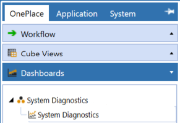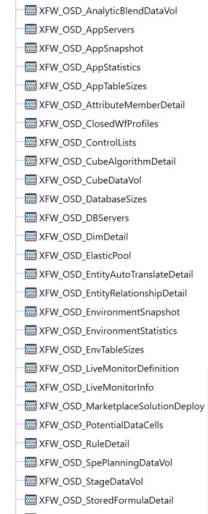Set Up System Diagnostics
The first time you run System Diagnostics, you are guided through the table setup process.
In OneStream, click OnePlace > Dashboards > System Diagnostics > System Diagnostics.

Create Tables
-
Click Step 1: Setup Tables.
This step may be necessary when upgrading even if tables are already present. System Diagnostics does not drop any tables that already exist, but modifies table structures and add any new ones if necessary.
The following tables are created in the OneStream framework database:

The Snapshot Automation scheduled task is created and can be edited in the Task Scheduler.

NOTE: You should receive the message Solution Table Created if this is a new implementation of System Diagnostics. If updating a previous release which includes changes to these tables, the message reads Solution Tables Upgraded.
See Also:
-
The Task Scheduler section in the Application Tools chapter of the Design and Reference Guide.
-
Click Step 2: Launch Solution to open System Diagnostics.
After setting up the solution’s tables, a task is created in Task Scheduler that takes Environment and Application snapshots on the third Saturday of each month. You can change the task frequency and timing using theTask Scheduler.
NOTE: The Task Scheduler is currently only available when using the OneStream desktop application.
Package Contents
The Dashboard Maintenance Unit provides the user interface for System Diagnostics and includes the required dashboard groups, components, data adapters, parameters and files.
Business Rules
The following business rules are included:
OSD_HelperQueries
Dashboard Data Set Business Rule. This rule provides query functions for collecting the activity and environment analysis information using a combination of SQL and programmatic data.
OSD_SolutionHelper
Dashboard Extender Business Rule. This rule provides various functions for the System Diagnostics solution and the Dashboard user interface.
OSD_ParamHelper
Dashboard XFBR String Business Rule. This rule provides conditional parameter processing functions that allow a parameter value to be interpreted and substituted with a different string.
OSD_LiveMonitoring
Extensibility Business Rule. This rule allows System Diagnostics to monitor system processing and collect metrics. This Business Rules is intended to be called from a Data Management step.
OSD_ApplicationSnapshot
Extensibility Business Rule. This rule facilitates Application and Environment manual and Task Scheduled snapshots.
Data Management
The following Data Management Sequences and steps are used with their related Business Rules (as described above). The benefit of running these processes through a Data Management sequence is that they can run in the background while the user continues their work.
Data Management sequences are:
-
AppSnapshot_OSD
-
EnvSnapshot_OSD
-
MonitorHealthEnv_OSD
-
MonitorHealthTask_OSD
- ReportPackage_OSD
-
SnapAutomation_OSD
Data Management steps are:
-
AppSnapshot_OSD
-
CreateReports_OSD
-
MonitorHealthEnv_OSD
-
MonitorHealthTask_OSD
-
SnapAutomation_OSD
-
TakeAppSnapshot_OSD
-
TakeEnvSnapshot_OSD
Data Management sequences used for application and environment snapshots, found in Task Scheduler for the System Diagnostic Automation task:
-
SnapAutomation_OSD
-
AppSnapshot_OSD